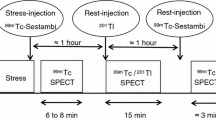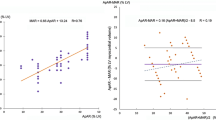Abstract
Thirty patients (26 men, 4 women, mean age 61 ± 8 years) who had suffered myocardial infarction 15 ± 6 months previously, were submitted to (1) standard stress-redistribution thallium-201 single photon emission tomography (SPET), (2) rest-redistribution201Tl SPET and (3) stress-rest technetium-99m sestamibi SPET. Uptake modifications in relation to exercise-induced defects were evaluated in a total of 390 myocardial segments. Tracer uptake was scored as normal (=0), mildly reduced (=1), apparently reduced (=2), severely reduced (=3) or absent (=4). Comparison of stress studies failed to show any statistical difference (58% segmental abnormalities with sestamibi vs 61% with thallium). Uptake abnormalities (score 1–4) were detected in 55% of the segments wiliest sestamibi, 55% with standard thallium redistribution, 55% with early imaging after thallium injection at rest and 54% with 3-h delayed rest imaging (P = NS). Absence of tracer uptake (score = 4) under resting conditions was recorded in 75 (19%) segments with standard201Tl redistribution, 75 (19%) with rest sestamibi, 70 (18%) with rest201Tl imaging and 62 (16%) with rst-rdistruion201Tl (P<0.05 vs other imaging modalities). Thus, 3-h delayed rest thallium imaging detected reversibility of uptake defects in a significantly higher number of myocardial segments. This finding might have important implications for both tracer and technique selection when myocardial viability is the main clinical issue.
Similar content being viewed by others
References
Beanlands RSB, Daward F, Wen WH et al. (1990) Are the kinetics of technetium-99m methoxyisobutyl isonitrile affected by cell metabolism and viability? Circulation 82:1802–1814
Berman DS, Kiat H, Van Train KF, Freedman J, Garcia EV, Maddahi J (1990) Comparison of SPELT using technetium-99m agents and thallium-201 and PET for the assessment of myocardial perfusion and viability. Am J Cardiol 66:72E-79E
Bonow RO, Dilsizian V, Cuocolo A, Bacharach SL (1991) Identification of viable myocardium in patients with chronic coronary artery disease and left ventricular dysfunction. Comparison of thallium scintigraphy with reinjection and PET imaging with18F-fluorodeoxyglucose. Circulation 83:26–37
Braunwald E, Rutherford JD (1986) Reversible ischemic left ventricular dysfunction: evidence for the “hibernating myocardium”. Circulation 6:1467–1470
Brundage BH, Massie BM, Botvinick EH (1984) Improved regional ventricular function after successful surgical revascularization. J Am Coll Cardiol 3:902–908
Brunken R, Schwaiger M, Grover-McKay M, Phelps ME, Tillish J, Schelbert HR (1987) Positron emission tomography detects tissue metabolic activity in myocardial segments with persistent thallium perfusion defects. J Am Coll Cardiol 10:557–567
Cloninger KG, DePuey EG, Garcia EV et al. (1988) Incomplete redistribution in delayed thallium-201 single photon emission computed tomography (SPELT) images: an overestimation of myocardial scarring. J Am Coll Cardiol 12:955–963
DePuey EG, Garcia EV, Alazraki NP, Robbins RD (1988) Comparison of thallium-201 and Tc-99m-methoxyisobutyl isonitrile (RP-30) for quantitative cardiac SPELT. J Nucl Med 29:793
Dilsizian V, Rocco TP, Freedman N et al. (1990) Thallium reinjection after stress-redistribution imaging: enhanced detection of ischemic and viable myocardium. N Engl J Med 323:141–146
Freeman I, Grunwald AM, Hoory S, Bodenheimer MM (1991) Effect of coronary occlusion and myocardial viability on myocardial activity of technetium-99-sestamibi. J Nucl Med 32:292–298
Gibson RS, Watson DD, Taylor GJ et al. (1983) Prospective assessment of regional myocardial perfusion before and after coronary revascularization surgery by quantitative thallium-201 scintigraphy. J Am Coll Cardiol 1:804–815
Gutman J, Berman DS, Freeman M et al. (1983) Time to complete redistribution of thallium-201 in exercise thallium-201 scintigraphy: relationship to degree of coronary artery stenosis. Am Heart J 108:989–995
Iskandrian AS, Hakki A, Kane SA et al. (1983) Rest and redistribution thallium-201 myocardial scintigraphy to predict improvement in left ventricular function after coronary arterial bypass grafting. Am J Cardiol 51:1312–1316
Iskandrian AS, Heo J, Helphant RH, Segal BL (1987) Chronic myocardial ischemia and left ventricular dysfunction. Ann Intern Med 107:925–927
Kahn JK, McGhie I, Akers MS et al. (1989) Quantitative rotational tomography with 201-Tl and 99m-Tc 2-methoxy-isobutil-isonotrile: a direct comparison of normal individuals and patients with coronary artery disease. Circulation 79:1282–1293
Kiat H, Berman DS, Maddahi J et al. (1988) Late reversibility of tomographic myocardial thallium-201 defects: an accurate marker of myocardial viability. J Am Coll Cardiol 12:1456–1463
Liu P (1991) Technetium-99m-sestamibi: another window on myocardial viability? J Nucl Med 32:298–299
Liu P, Kiess MC, Okada RD et al. (1985) The persistent defect on exercise thallium imaging and its fate after myocardial revascularization: does it represent scar or ischemia? Am Heart J 110:996–1001
Machac J (1989) Technetium-99m isonitrile: a perfusion or a viability agent? J Am Coll Cardiol 14:1685–1688
Maddahi J, Kiat H, Van Train F et al. (1990) Myocardial perfusion imaging with technetium-99m sestamibi SPELT in the evaluation of coronary artery disease. Am J Cardiol 66:55E-62E
Manyari DE, Knudtson M, Kloiber R, Roth D (1988) Sequential thallium-201 myocardial perfusion studies after successful percutaneous transluminal coronary angioplasty: delayed resolution of exercise-induced scintigraphic abnormalities. Circulation 76:86–95
Mock MB, Ringqvist I, Fisher LD et al. (1982) Survival of medically treated patients in the coronary artery surgery study (LASS) registry. Circulation 66:562–568
Mousa SA, Williams SJ, Sands H (1987) Characterization of in vivo chemistry of cations in the heart. J Nucl Med 28:1351–1357
Piwnica-Worms D, Krounauge JF, Delmon L, Holman BL, Marsh JD, Jones AG (1990) Effect of metabolic inhibition on technetium 99m-MIBI kinetics in cultured chick myocardial cells. J Nucl Med 31:464–472
Pohost GM, Zir LM, Moore RH et al. (1977) Differentiation of transiently ischemic from infarcted myocardium by serial imaging after a single dose of thallium-201. Circulation 55:294–302
Rahimtoola SH (1989) The hibernating myocardium. Am Heart J 117:211–213
Rocco TP, Dilsizian V, Strauss HW, Boucher CA (1989) Technetium-99m isonitrile myocardial uptake at rest. II. Relation to clinical markers of potential viability. J Am Coll Cardiol 14:1678–1684
Rozanski A, Berman DS, Gray R et al. (1981) Use of thallium-201 redistribution scintigraphy in the preoperative differentiation of reversible and nonreversible myocardial asynergy. Circulation 64:936–944
Sinusas AJ, Watson DD, Cannon JM Jr, Beller GA (1989) Effect of ischemia and postischemic dysfunction on myocardial uptake of technetium-99m-labeled methoxyisobutyl isonitrile and thallium-201. J Am Coll Cardiol 14:1785–1793
Taillefer R, Lambert R, Dupras G, Gregoire J, Leveille J, Phaneuf DC (1989) Clinical comparison between thallium-201 and Tc-99m methoxy isobutyl isonitrile (MIBI) myocardial perfusion imaging for detection of coronary artery disease. Eur J Nucl Med 15:280–286
Tillisch J, Brunken R, Marshall R et al. (1986) Reversibility of cardiac wall motion abnormalities predicted by positron emission tomography. N Engl J Med 314:884–888
Wackers FJT, Berman D, Maddahi J et al. (1989) Technetium-99m hexakis 2-methoxyisobutyl isonitrile: human biodistribution, dosimetry, safety and preliminary comparison to thallium-201 for myocardial perfusion imaging. J Nucl Med 30:301–311
Author information
Authors and Affiliations
Rights and permissions
About this article
Cite this article
Dondi, M., Tartagni, F., Fallani, F. et al. A comparison of rest sestamibi and rest-redistribution thallium single photon emission tomography: Possible implications for myocardial viability detection in infarcted patients. Eur J Nucl Med 20, 26–31 (1993). https://doi.org/10.1007/BF02261242
Received:
Revised:
Issue Date:
DOI: https://doi.org/10.1007/BF02261242




